Glendale Invests in Safe and Healthy Streets for a Safe and Healthy Future
This series on the grants from the L.A. County Department of Public Health's Policies for Livable and Active Communities and Environments (PLACE) Grants focuses on Glendale and their groundbreaking Safe and Healthy Streets Plan.
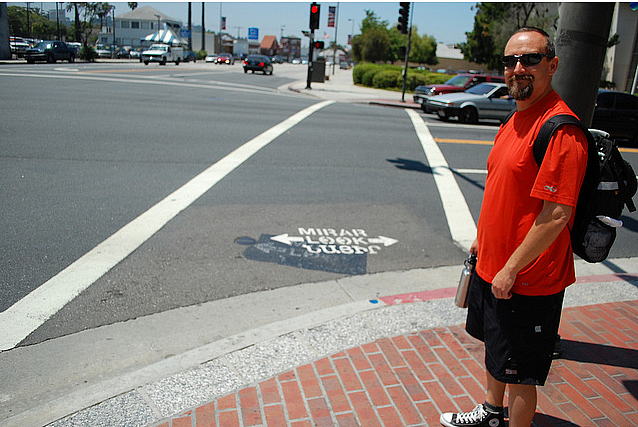
Glendale PLACE Grant Coordinator Colin Bogart shows off the new tri-lingual pedestrian safety markings at an intersection adjacent to Glendale City Hall.
Glendale’s grant was different than most because it wasn’t the city that was actually awarded the grant, but the Los Angeles County Bicycle Coalition (LACBC). The LACBC and the city worked together on the grant application. We’ll discuss the unique collaboration between the LACBC and Glendale tomorrow. On Friday we’ll discuss some of the physical changes that have happened over the last three years and that are currently underway.
Today, we’ll focus on Safe and Healthy Streets, the planning document passed unanimously by the city in June and how their plan sets a new bar for clean and green transportation planning in Los Angeles County.
For their part, the City of Glendale professes confidence and optimism that Safe and Healthy Streets will bring a change to the city’s transportation grid.
“People in Glendale are really frustrated by our record on traffic safety,” provides Mayor Laura Friedman. “It’s a way to get a grip on traffic safety in the city, and it’s probably the most cohesive effort we’ve ever had.”
The Baseline: Glendale knew it had a problem and was open to change.
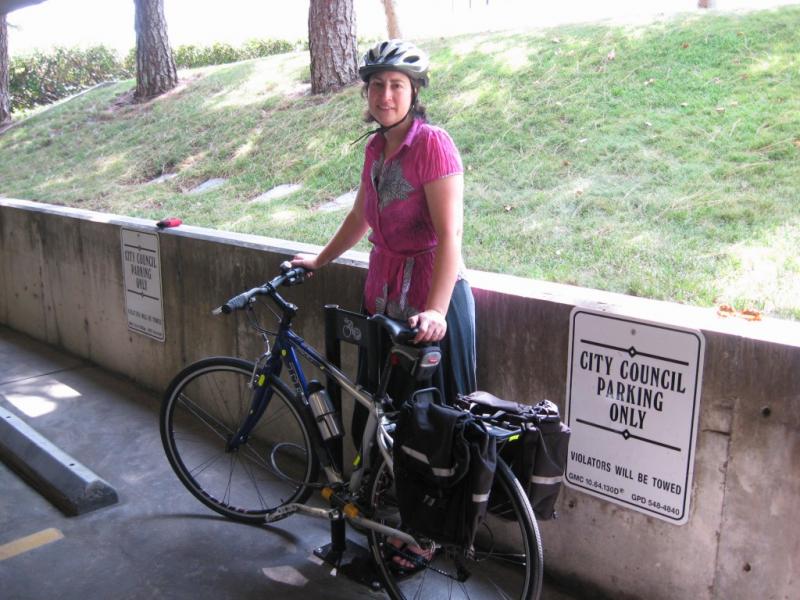
When she first joined the City Council, Laura Friedman (pictured above) pushed for bike parking at City Hall. Now the City's racks are partially filled everyday by staff with a few spots held for visitors. The LACBC's Jen Klausner calls the racks "beautiful."
By its own admission, Glendale was in desperate need for a new approach to transportation planning. The unintended consequences of a transportation network that emphasized moving cars can be seen in the statistics. In Glendale, approximately 17.4% of adults (age 18+) are obese as are approximately 15.8% of children. An additional 46. 2% of adults and 17.9% of children are overweight. Many of Glendale’s health problems could be solved by a transportation system that emphasizes “people powered” transportation, but for years they weren’t ready to make the change. In 2008, almost 40% of adults in Glendale engage in minimal to no physical activity and 66.4% of adults drive to go on an errand less than one mile from their home.
Street safety for pedestrians and bicyclists is another major issue. Mayor Friedman, admits that Glendale has an “abysmal record of pedestrian safety.” From 2004 through 2009, there were 671 reported motor vehicle collisions involving pedestrians and 275 reported motor vehicle collisions involving bicyclists, according to data provided by the state. Of the pedestrian collisions, the primary collision factor (cause of the crash) was assigned to the motorist in 64% of the collisions; to the pedestrian in 22% of the collisions, and 14% of the collisions reported remain unknown or unclear.
Some residents believe that fear is one of the reasons that more people in Glendale don’t bike. “This is a unique city. We have a huge driving problem here, and the speed and the recklessness is beyond comprehension sometime,” commented Nathalie Winiarski. “We need a huge campaign to battle this.”
So how does Safe and Healthy Streets address those problems? Instead of a traditional transportation planning document, the kind that lists what streets get what treatments, Safe and Healthy Streets proposes a series of policy changes which shift the way the city views transportation, reprioritizes funding allocation that will ultimately lead to a changed city with a progressive transportation plan. Of course, a plan is only as good as the follow-through, but in the short-term Glendale staff and elected leaders seem serious about creating a different Glendale.
Which isn’t to say that Glendale abandoned traditional planning all together. Safe and Healthy Streets identifies the traditional “5 e’s” (education, enforcement, engineering, encouragement, and evaluation) of transportation planning, and then outlines specific policy changes to turn streets designed for cars into streets that are safe for all road users and to promote healthy lifestyles. The Safe and Healthy Streets plan closes with a section on implementation which is somewhat vague. Whether the plan becomes reality depends on the political will of Glendale’s elected leadership, which is currently committed to the vision.
While Safe and Healthy Streets embraces all 5 e’s, where it differs is how it treats engineering programs. Safe and Healthy Streets calls for an overhaul of transportation planning in Glendale so that the needs of bicyclists and pedestrians. Even before the plan was passed, this new commitment was embraced by the planning and street services departments.
Engineering
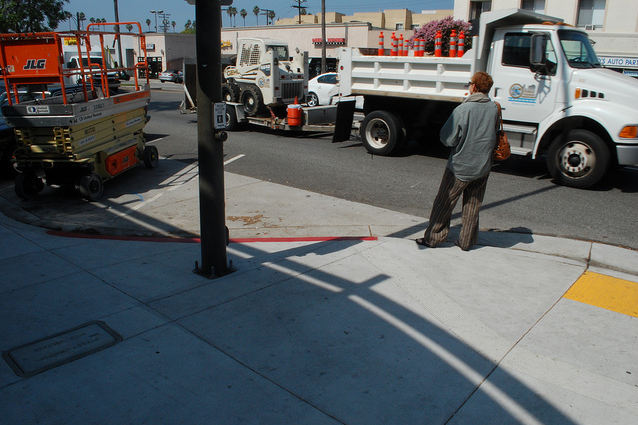
The now-famous Mercedes dealership bump out. Work goes on in the street.
When it comes to the design of Glendale’s streets, the city didn’t wait until the plan was finalized to begin the long project of retrofitting its transportation network to accommodate bicyclists and pedestrians.
“We’re happy with the document,” explains LACBC Executive Director Jennifer Klausner. “… we’re also happy with the real on-the-ground changes we saw during our partnership.”
The saga of the efforts of the LACBC’s efforts to get Shared Lane Markings (Sharrows) on streets in Los Angeles is familiar to most regular Streetsblog readers, but for those who are new here is a quick summary. It took over five years, dozens of public meetings, before LADOT finally relented. In Glendale, the third largest city in L.A. County, it took one private meeting. Sharrows are now on five streets in Los Angeles (although 20 more miles of Sharrowed Streets are in the works) and on five streets in Glendale.
The city’s success with Sharrows had another, almost psychic benefit to the city. Every single person I spoke with to prepare for this series brought up an attempt to put bike lanes on Verdugo Avenue over ten years ago that led to such a backlash that city staff literally cringed at its mention. But for Sharrows, the reaction was different. Mayor Friedman commented that “98%” of the feedback she received was positive.
Mike Nilson with City Planning, took it one step further, “Before Sharrows, people looked at bike projects as ‘taking away parking’ or ‘taking away car travel lanes.’” And now the city is ready to move beyond Sharrows and try adding bike lanes again. Plans are in the work for bike lanes as part of the Riverdale-Maple Greenway and a separate project is scheduled for Main Street.
As for the Sharrows, the city plans to continue to use them when bike lanes aren’t appropriate and has even placed them on some streets without car parking, a move that other cities in L.A. County believes violates the federal standard because Sharrows were originally designed to place bicycles in the safest part of the street. In Glendale, they also serve to remind drivers that streets are for cyclists too.
Safe and Healthy Streets also calls for better crossings at intersections. When Glendale was planning to improve the intersection of Maple and Riverdale, the intersection was due for a new traffic signal, but thanks to the intervention of city staff and LACBC’s Place Coordinator Colin Bogart, the intersection underwent a dramatic change. Bump outs shorten the length of the Riverdale crossing so pedestrians aren’t as daunted and car traffic is slowed by the narrower street. Bike detectors are under the concrete so that cyclists don’t have to hop on and off the sidewalk to press a button or wait for a car to come along to get a green light. Signs direct cyclists how to navigate the difficult turn to stay on the existing bike route and future Greenway.
Another example is that when a Mercedes dealer was fixing the sidewalks in front of the dealership as part of an expansion project, City staff informed the dealership that they had to provide better pedestrian access along the street including bump outs to slow car traffic and provide pedestrians a shorter crossing along the city’s dealership row.
These small changes begin to add up to a changed street life in Glendale. It’s not as though the city has transformed from a car dominated transportation system to Copenhagen, but small changes add up over time. Sharrows, better crossings, traffic calming, these are all things that weren’t a part of Glendale’s plan a couple of years ago, but are all in the mix now whenever a transportation project is considered.
“I do believe the public works department is taking this very seriously,” Friedman says of the change in direction. “When I ask them ‘is this a complete streets project?’ they almost always say yes…That’s a change in policy for the city.”
City staff readily agrees. “The philosophical change is that now giving consideration to the bikes and pedestrians is standard,” provides Kevin Carter with the city’s Public Works and Engineering Department. “Every project that comes through, we’re looking at what can be done for bike and pedestrians.”
The next immediate step is the construction of a series of Greenways to connect Glendale’s three main parks. Construction of the Riverdale-Maple Greenway is part of their PLACE Grant, and is designed not only to connect parks but provide an east-west pedestrian and bicycle connection through a part of the city that is less affluent and has higher percentages of minority residents. Streetsblog will have more on the Greenway on Friday.
The next steps for Glendale are to revise its Master Plan to reflect this new commitment and pass a Complete Streets policy. Both items are currently being worked on by city staff.
In addition to clarifying Glendale’s policy of safe streets for all users, Safe and Healthy Streets also recommends major changes in how the city counts traffic to mirror the commitment to safe streets. Much as we see in Los Angeles and other cities around L.A. County, excluding Long Beach, Glendale traffic engineers decide whether a street is working based on a Level of Service calculation of how many cars the street moves. More progressive cities are embracing the idea that traffic counts should be people counts and the number of pedestrians, bicyclists and people on a bus are just as important as the number of people riding in cars.
The city believes all these changes will lead to more people walking and bicycling for local trips and history with other cities, both in L.A. County and around the world, backs up that claim. Or, put more succinctly the city believes that “If you build it, they will come.”
Enforcement
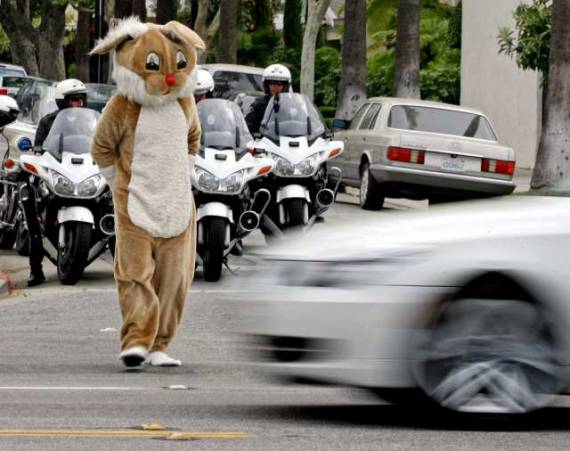
Too subtle? (Photo: Glendale News Press)
In some ways, Glendale has become a state leader in the battle for safe streets. Over the past several years, the Glendale Police Department (GPD) and local Assembly Members have pushed for new legislation that would allow the city greater control over local speed limits. While larger cities have mostly stayed on the sidelines, the City of L.A. passed an ordinance and held a press conference in 2009 but failed to actually show up in Sacramento to lobby or testify in support of the legislation, Glendale has pushed and kept pushing for legislation that would make their streets safer.
Safe and Healthy Streets calls for the GPD to remain a leader in this fight, and calls for better training of officers on the rights of bicyclists and pedestrians. It also calls for a lighter touch when dealing with cyclists, especially younger cyclists, so the Department doesn’t discourage bicycling by cracking down on riders for minor violations. For example, the GPD will seek funding for lights and bike helmets to give to young riders instead of just ticketing them.
But cases over the last two years demonstrate the difficulties of enforcing traffic laws fairly in a world where many drivers routinely violate the law and many parts of the legal code are unclear.
In the days leading up to Easter of 2010, one Glendale officer literally dressed as the Easter Bunny and walked across the intersection of Broadway and Central. Motorists that failed to yield to the bunny were ticketed for their infraction and sent on their way. This outside-the-box thinking led to a lot of free press for the city, in Glendale and beyond, but was ultimately scrapped when City Councilman John Drayman complained. However, it’s an interesting case study in targeted enforcement, and it certainly demolished the argument often heard from drivers who violate pedestrian space. It’s awfully hard to miss a person in a bunny suit.
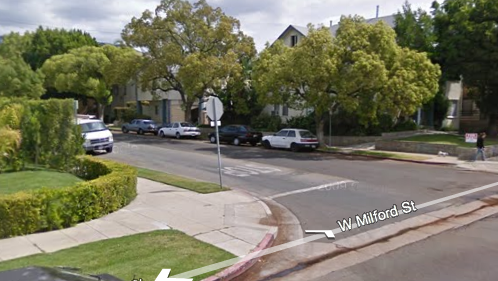
Would you think of this as a “Business District?” (Image: Google Street View)
The second story is a lot more tragic, and shows how Glendale law needs a change to protect cyclists. Safe and Healthy Streets explains the problem:
The City of Glendale’s Municipal Code 10.64.025 currently prohibits sidewalk riding in business districts. “No person shall ride or operate a bicycle upon any public sidewalk in any business district within the city except where such sidewalk is officially designated as part of an established bicycle route.” The existing law lends itself to confusion, as there are no specific boundaries in Glendale that outline where a business district begins or ends and most people are not familiar with the default definition of a business district as defined by the vehicle code. It also fails to address the needs of inexperienced or young riders who may wish to ride to a business destination.
California Vehicle Code Section 240 determines if a roadway is in a business or residential district. CVC Section 240 part C reads, “All churches, apartments, hotels, multiple dwelling houses, clubs, and public buildings, other than schools, shall be deemed to be business structures.” This determination means that neighborhoods with multi-family dwellings are considered business districts. This makes the current Glendale Municipal Code even more problematic since it opens sidewalk riders to citation and potential legal problems when riding in such areas.
Thus, when a rider was struck and killed in September of 2008 while riding on the sidewalk. The rider was in a clearly residential area, that is technically a business district under city law, so the slain rider was deemed partially responsible. Changing this law is considered of paramount importance and Safe and Healthy Streets gives several options to do so, including eliminating sidewalk riding completely so that there is no confusion.
While Safe and Healthy Streets provides guidance for the City Council, Mayor and GPD and not hard policy, addressing laws and enforcement issues is not something one sees in a planning report and is an example on how the Safe and Healthy Streets document is an improvement over a traditional Master Plan document.
Encouragement
In some ways, the encouragement section reads like a traditional encouragement plan. The city promises to produce bicycle road maps, maps of pedestrian zones, Safe Routes to Schools maps and even mountain biking maps, while promising special events that highlight walking and bicycling. Where Safe and Healthy Streets has excelled isn’t in the planning of these events, but the execution that has happened in recent years.
Glendale doesn’t just have a Bike to Work Day and Bike Week as does its giant neighbor to the south and west, it has a Bike Month that had over 20 free events in 2010. It doesn’t program a Mayor’s ride once a year as part of a press event, it has them regularly (which is easier when you have a mayor that chooses to ride herself), the next one is on September 25. For a mid-sized American city to have a bike calendar similar to Glendale’s is unheard of, with official events on the calendar a couple of times a month year-round.
But Safe and Healthy Streets calls for more special events, so many that the events become less-special and more routine. Why have a “walk and bike to school day” when you can have “Walk to School Wednesdays” or “Car-Free Fridays?” Making these days a regular part of the calendar would require a strong partnership with the school district, but it’s a relatively easy way to combat childhood obesity and studies show that students learn more if they have some exercise before class.
Marc Stirdivant, who worked the LACBC on the initial grant, noted that more came from the rides than new riders, but also a new constituency. “Culture change also came as a result of the rides. Ice Cream Rides. Weekend Rides. Bike to Work Rides. All of a sudden there were 60 people and they all realized they were concerned about the same things.”
Education
Go to the three minute point to see a PSA made by Glendale Grade Schoolers.
Much of the Safe and Healthy Streets proposed educational campaign is pretty standard fare, but where the plan shows some creativity is that it’s not afraid to grab on to some of the best practices of local municipalities.
In other words, the education component is about more than P.S.A.’s and snap bracelets that encourage cyclists to “ride right.”
For example, when someone gets a traffic ticket driving a car in California, they have the option to go to “Traffic School” to reduce the penalty they receive. Except for a few smaller cities, bicyclists don’t have the same opportunity. Safe and Healthy Streets pushes the city to change that for cyclists in Glendale.
When adopted, Bicyclists that are given tickets for traffic violations would have the option of attending a class on how to safely use a bicycle in traffic in lieu of paying the moving violation fine. Attendance at a Bicycle Traffic School requires a court order granted by the Traffic Court Judge and can only be issued once instead of paying the fine. Cyclists and pedestrians can pay anywhere from $100 to $200 per ticket, depending on the infraction. By attending the bicycle safety class the cyclist can not only save money, but also his or her life by learning essential safety rules. The cost of the program is negligible because the “students” will pay “tuition” to the school to cover expenses.
Safe and Healthy Streets also calls for the city to create bike co-ops similar to the Bicycle Kitchen, Bike Oven, Bikerowave, Valley Bikery and Bici Digna co-ops in the City of L.A. These storefronts serve not just as places where people can learn how to fix their bicycle, but also as social gathering points for cyclists to get together and places to hold bike-themed events.
Evaluation
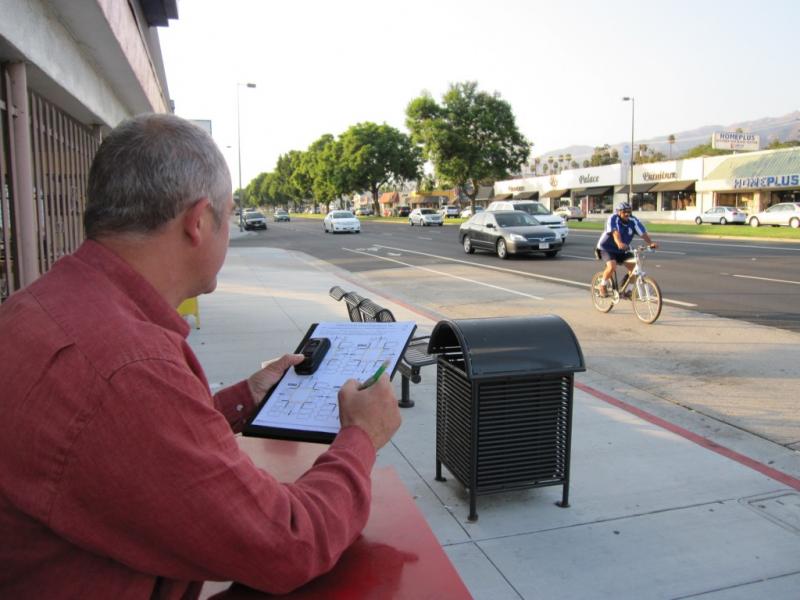
Volunteer Guillaume Lemoine records a cyclist on Glenoaks at Grandview. (Photo:LACBC/SaHS)
One of the most important, and oft-overlooked, part of a plan is the evaluation stage and specifically who is going to be doing the evaluating. One of the main short-term recommendations of Safe and Healthy Streets is to create advisory bodies of city staff and residents to review and update the plan and hold the city accountable to implement the plan. Details on the makeup of each body is pending, the City Council will hear a recommendation on how to create the citizens’ committee this month.
Measuring the success of its bicycle and pedestrian program is something new for Glendale. “Before the PLACE Grant, people believed that nobody wanted this,” laughed Stirdivant when I asked about evaluation plans. Now the city is figuring out how to provide for a constituency that it didn’t believe existed three years ago.
However, the document does outline what criteria should be used to monitor the plan’s successes and shortcomings:
• Increasing the mode share of bicyclists in the City of Glendale
• Increasing the number of bicyclists and pedestrians recorded during the annual bicycle/pedestrian count
• Increasing the rate of school children walking or bicycling to school
• Increasing the rate of residents walking or bicycling to work, for errands, and recreation
• Decreasing the mode share of single-occupancy vehicular riders in the City of Glendale
• Coordinating with other programs, such as Safe Routes to School, to include schools as part of the yearly count
• Incorporating a Mode of Travel survey into schools as part of the City’s yearly pedestrian and bicycle count
How Will Glendale Do It?
Of course, the largest issue for any plan, be it a Master Plan or Vision Plan, or a hybrid such as Safe and Healthy Streets, is how the plan will be funded and who will see that it moves from paper to the street.
In some ways, Glendale is hamstrung by what ails every city in North America. The country’s budget crisis has hit Glendale hard with hiring freezes in place so the newly created position of Pedestrian and Bicycle Coordinator will most likely go unfilled for years. The City is looking for grant opportunities to help fund these positions, but so far has come up short. And even as the city embraced Safe and Healthy Streets, the city’s budget for transportation improvements was cut.
While many are enthusiastic about the plan, they’re also worried the funding issue could keep it from becoming a reality. Nathalie Winiarski, a resident of Glendale who worked on Safe and Healthy Streets as a Volunteer, explains. “I do feel the city is behind this. It’s a funding situation. I do believe everyone who I’ve come in contact with is very much in favor of this, but until the money is there we don’t know where it’s going to go.”
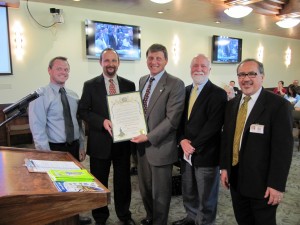
L to R: Mike Nilsson, Colin Bogart, Councilman Ara Najarian, Marc Stirdivant and Chuck Wike with Mayor Friedman's proclamation that May is Bike Month in Glendale
Which isn’t to say that funds aren’t available to do some great things. For example, Metro estimates that the City of Glendale will receive as much as $113 million dollars in local return funds from the 2008 county-wide transit sales tax. These funds may be used for a variety of transportation improvements including pedestrian and bicycle infrastructure and safety measures. Safe and Healthy Streets recommends that Glendale follow the lead of Los Angeles and dedicate 10% of that return to bicycle and pedestrian projects. L.A. is planning on its set-aside to cover a lot of the city’s Bike Master Plan, and Glendale could do the same for its Master Plan which is still being designed.
Measure R isn’t the only place Glendale is looking for funding. In 2009 the city received a nearly $900,000 grant from Caltrans to improve safe passing at six local schools. One year later, the GPD received over a quarter of a million dollars to better train officers about pedestrian and bicyclist rights.
The City has applied for and received two grants as part of the Federal Highway Safety Improvement Program for two projects. The first, in the amount $376,200, is for traffic safety improvements at the intersection of Honolulu Avenue, Verdugo Road, Montrose Avenue, and Verdugo Boulevard. This project will be completed in 2012. The second project, in the amount of $322,640, will upgrade traffic signal for motorist and pedestrian safety at the intersection of Wilson Avenue, Harvey Drive, and Broadway. This project will also be completed in 2012.
With funding tight, the city is reliant on outside funding sources and grants to make its streets fulfill the promises of Safe and Healthy Streets. There’s a long way to go, but if the City maintains the political will and manages to find the money, Glendale might, one day, be the model of a safe and healthy community.

